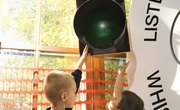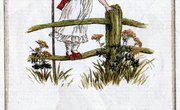“Mommy, he said I had a pretty pair of shoes, but my shoes aren’t pears,” your daughter whispers. “I think he’s silly. I wouldn’t wear pear shoes!” Words that sound alike can confuse your preschooler, so you might find her confusion amusing as you begin to teach her about pairs. Many things come in pairs, so you have many options that illustrate the concept. From identifying paired body parts to shoes and pants or matching cards, she will discover that pears and pairs are two very different things.
Ask your child, “Can you tell me which body parts come in twos?” He might list feet, hands, eyes and ears. You can explain, “If you have two things that look the same, they make a pair. So, you have a pair of eyes, ears, hands and feet. Things that go with those body parts also come in pairs. Grandma has a pair of glasses. You have pairs of shoes, sock and mittens. Daddy has a pair of head phones that go with his music player. Can you name other pairs?” Let him look around the room and find other pairs.
Explain that some pairs are a single thing. “Mommy, how can Grandma wear a pair of glasses if she only has one? They don’t match.” “That’s a good question,” you might agree. “We say you have a pair of pants, shorts or underwear. Those items are only one thing, too. Can you think why it might be called a pair?” She might decide it’s a pair because she has two legs or the glasses are for two eyes. That’s probably simple enough for your preschooler, although you might explain that pants once came in two pieces, one for each leg. You might also say, “There are other items that are called pairs, such as scissors and binoculars. We call those exceptions, which just means they don’t follow the rules.”
Play a matching game with him to match pairs of cards. You could make the cards yourself or use a commercial deck of cards. “Can you help me find cards that go together as a pair?” you might ask. If you use items that are just a little different, such as red balls and green balls, you can explain, “They must be exactly alike. The red ball only goes with the red ball. A green ball and a red ball don’t make a pair.” Praise him when he correctly matches all of the card pairs.
Related Articles
References
Writer Bio
Rev. Kathryn Rateliff Barr has taught birth, parenting, vaccinations and alternative medicine classes since 1994. She is a pastoral family counselor and has parented birth, step, adopted and foster children. She holds bachelor's degrees in English and history from Centenary College of Louisiana. Studies include midwifery, naturopathy and other alternative therapies.











